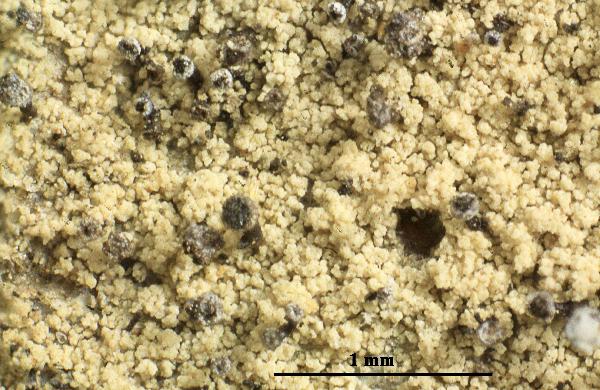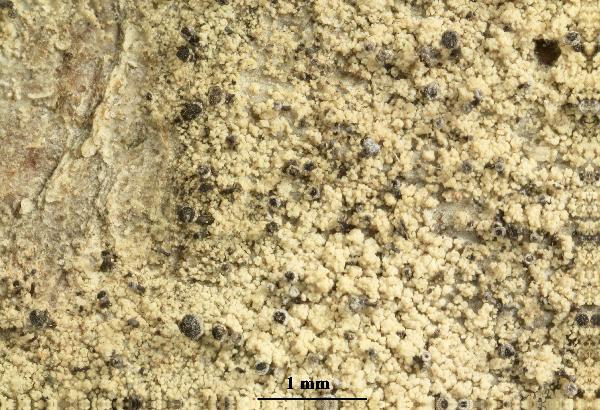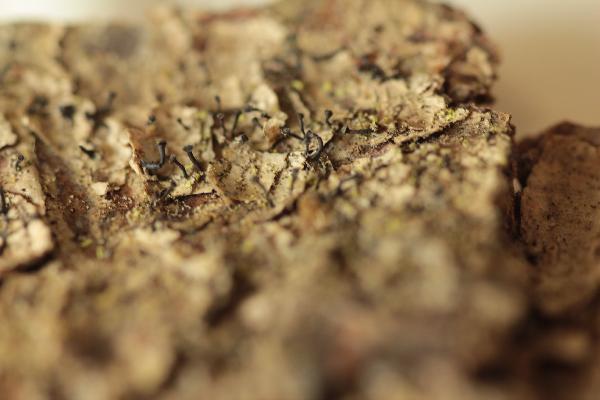Calicium lenticulare Ach.
K. Vetensk.-Akad. Handl.: 262, 1816.
Synonyms: Calicium amylocaule Lettau; Calicium atroviride Körb.; Calicium cladoniscum auct.; Calicium lenticulare var. cladoniscum auct. non Schaer.; Calicium quercinum var. lenticulare (Ach.) Nyl.; Calicium schaereri sensu Nádv. non De Not.; Calicium subquercinum Asahina; Calicium virescens (Schaer.) Hepp
Description: Thallus crustose, endosubstratic and poorly evident or more often episubstratic and granular-verrucose, greenish to yellowish grey, sometimes with a bluish tinge. Apothecia long-stalked, pin-like, most often with a whitish pruina on the lower side of capitulum, more rarely epruinose. Stalk black to dark reddish brown, 0.5-1.3 mm high, 0.08-0.22 mm thick, of sclerotized, dark, irregularly interwoven hyphae, in section distinctly reddish brown, sometimes with strands of granular crystals, the outer layer covered with a very thin, transparent, non-amyloid gelatinous sheath. Capitulum narrowly obconical to lenticular, 0.2-0.55 mm across, with a well-developed, cup-shaped exciple of intertwined, sclerotized hyphae; mazaedium well developed, black; hypothecium blackish brown, with a convex upper surface. Asci narrowly clavate to cylindrical, formed singly, dissolving early, with partly 2-seriate ascospores. Ascospores at first simple, then (when released from asci) 1-septate, dark brown, broadly ellipsoid to ellipsoid, (9-)11-12 x (4-)6-7 µm, with a thick, minutely verrucose to areolate wall. Photobiont chlorococcoid. Spot tests: thallus K-, C-, KC-, P-; ascomata I+ deep blue to blue-black in all parts. Chemistry: thallus without lichen substances or with placodiolic and sometimes 4-O-methylhypoprotocetraric acids.
Growth form: Crustose
Photobiont: green algae other than Trentepohlia
Reproductive strategy: mainly sexual
In underhangs rarely wetted by rain
Commonnes-rarity: (info)
Alpine belt: absent
Subalpine belt: very rare
Montane belt: extremely rare
Dry submediterranean belt: absent
Humid submediterranean belt: absent
Padanian area: absent
pH of the substrata:
1 2 3 4 5
Solar irradiation:
1 2 3 4 5
Aridity:
1 2 3 4 5
Eutrophication:
1 2 3 4 5
Poleotolerance:
0 1 2 3
Altitudinal distribution:
1 2 3 4 5 6
Rarity
absent
extremely rare
very rare
rare
rather rare
rather common
common
very common
extremely common
Loading data...
Occurrence data
Predictive map

P.L. Nimis; Owner: Department of Life Sciences, University of Trieste
Herbarium: TSB (5970)
2001/12/05

P.L. Nimis; Owner: Department of Life Sciences, University of Trieste
Herbarium: TSB (9352)
2001/12/05

Felix Schumm- CC BY-SA 4.0
[17164], Brasilien, São Paulo, zwischen São Laurenço und Juquií etwa 65 km W von São Sebastião, am Rio Guaratuba, in einer Mangrove aus Rhizophora mangle und Laguncularia racemosa, an abgestorbenen Bäumen, 1 m, 23°47' S, 45°44' W. Leg. K. Kalb, 19.02.1980, det. L. Tibell. KALB: LICHENES NEOTROPICI 489.

Felix Schumm- CC BY-SA 4.0
[17221], Brasilien, Minas Gerais, Serra do Espinhaço, Serra do Caraça, unterhalb des Klosters Caraça (Hauptsammelgebiet von Vainio im Jahr 1885). An Rinde in einem hellen, feuchten Wäldchen, 1200 m, 20°10' S, 43°30' W. Leg. K. Kalb & G. Plöbst, 08.07.1978, det. L. Tibell,1987. KALB: LICHENES NEOTROPICI 583

Felix Schumm - CC BY-SA 4.0
[VZ1655], U.R.S.S., Transcaucasia, Colchis. Distr. Chota, ad latera
austro-orientalia iugi montium Achun, in valle fluminis Chosta, 400 m.
Ad corticem Fagi orientalis, leg. V Vašák et A. V zda, 15.06.1979. EX
A. V ZDA: LICHENES SELECTI EXSICCATI NR. 1655, distributed as
Calicium subquercinum Asah.

Felix Schumm - CC BY-SA 4.0
[VZ1655], U.R.S.S., Transcaucasia, Colchis. Distr. Chota, ad latera
austro-orientalia iugi montium Achun, in valle fluminis Chosta, 400 m.
Ad corticem Fagi orientalis, leg. V Vašák et A. V zda, 15.06.1979. EX
A. V ZDA: LICHENES SELECTI EXSICCATI NR. 1655, distributed as
Calicium subquercinum Asah.
Growth form: Crustose
Photobiont: green algae other than Trentepohlia
Reproductive strategy: mainly sexual
In underhangs rarely wetted by rain
Commonnes-rarity: (info)
Alpine belt: absent
Subalpine belt: very rare
Montane belt: extremely rare
Dry submediterranean belt: absent
Humid submediterranean belt: absent
Padanian area: absent
pH of the substrata:
| 1 | 2 | 3 | 4 | 5 |
Solar irradiation:
| 1 | 2 | 3 | 4 | 5 |
Aridity:
| 1 | 2 | 3 | 4 | 5 |
Eutrophication:
| 1 | 2 | 3 | 4 | 5 |
Poleotolerance:
| 0 | 1 | 2 | 3 |
Altitudinal distribution:
| 1 | 2 | 3 | 4 | 5 | 6 |
Rarity
absent
extremely rare
very rare
rare
rather rare
rather common
common
very common
extremely common
Loading data...
Occurrence data
Predictive map

P.L. Nimis; Owner: Department of Life Sciences, University of Trieste
Herbarium: TSB (5970)
2001/12/05

P.L. Nimis; Owner: Department of Life Sciences, University of Trieste
Herbarium: TSB (9352)
2001/12/05

Felix Schumm- CC BY-SA 4.0
[17164], Brasilien, São Paulo, zwischen São Laurenço und Juquií etwa 65 km W von São Sebastião, am Rio Guaratuba, in einer Mangrove aus Rhizophora mangle und Laguncularia racemosa, an abgestorbenen Bäumen, 1 m, 23°47' S, 45°44' W. Leg. K. Kalb, 19.02.1980, det. L. Tibell. KALB: LICHENES NEOTROPICI 489.

Felix Schumm- CC BY-SA 4.0
[17221], Brasilien, Minas Gerais, Serra do Espinhaço, Serra do Caraça, unterhalb des Klosters Caraça (Hauptsammelgebiet von Vainio im Jahr 1885). An Rinde in einem hellen, feuchten Wäldchen, 1200 m, 20°10' S, 43°30' W. Leg. K. Kalb & G. Plöbst, 08.07.1978, det. L. Tibell,1987. KALB: LICHENES NEOTROPICI 583

Felix Schumm - CC BY-SA 4.0
[VZ1655], U.R.S.S., Transcaucasia, Colchis. Distr. Chota, ad latera austro-orientalia iugi montium Achun, in valle fluminis Chosta, 400 m. Ad corticem Fagi orientalis, leg. V Vašák et A. V zda, 15.06.1979. EX A. V ZDA: LICHENES SELECTI EXSICCATI NR. 1655, distributed as Calicium subquercinum Asah.














